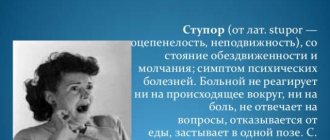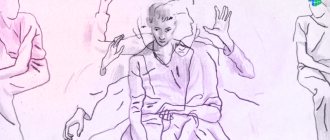Catatonic stupor is a state of psychomotor immobility and behavioral disturbances manifested by stupor. It was first described in 1874 by Carl Ludwig Kahlbaum in German: Die Katatonie oder das Spannungsirresein (Catatonia or Tension Insanity).
Although catatonia has historically been associated with schizophrenia (catatonic schizophrenia), it is now known that catatonic symptoms are nonspecific and can be observed in other mental disorders and neurological conditions. The fifth edition of the Diagnostic and Statistical Manual of Mental Disorders (DSM) does not recognize catatonia as a separate disorder, but is associated with psychiatric conditions such as schizophrenia (catatonic type), bipolar disorder, post-traumatic stress disorder, depression and other mental disorders, narcolepsy, and also drug abuse or overdose (or both). It may also occur in many medical disorders, including infections (such as encephalitis), autoimmune disorders, focal neurological lesions (including strokes), metabolic disorders, alcohol withdrawal, and abrupt or too rapid benzodiazepine withdrawal. The fifth edition of the DSM states that various medical conditions can cause catatonia, especially neurological conditions: encephalitis, cerebrovascular disease, neoplasms, head trauma. In addition, metabolic conditions: homocystinuria, diabetic ketoacidosis, hepatic encephalopathy, hypercalcemia.
This may be an adverse reaction to prescribed medications. This has similarities to conditions such as encephalitis lethargica and neuroleptic malignant syndrome. There are many treatments available; Benzodiazepines are the first-line treatment strategy. Electroconvulsive therapy is also sometimes used. There is growing evidence of the effectiveness of NMDA receptor antagonists in benzodiazepine-resistant catatonia. Antipsychotics are sometimes used but require caution because they can worsen symptoms and have serious side effects.
Types of catatonic stupor
Stupor is a motionless, apathetic state in which a person does not notice or respond to external stimuli. Motor activity is practically absent. People in this state see little or nothing of each other and may be mute and rigid. It is possible to stay in one position for a long period of time and then immediately move to another position immediately after the first position.
Catatonic arousal is a state of constant, aimless agitation and agitation. People in this state are extremely hyperactive, although, as mentioned, the activity seems to have no purpose. The person may also experience delusions or hallucinations. It is commonly referred to as one of the most dangerous mental conditions in psychiatry.
Malignant catatonia is the acute onset of agitation, fever, autonomic instability, delirium, and can be fatal.
Causes of development of dissociative stupor
The source is always a traumatic situation, but the nature, duration and objective significance of these situations can vary greatly. Clinically significant stupor occurs most often during large, destructive events that pose an immediate threat to human life. These include floods, earthquakes, hurricanes, house collapses, industrial accidents, train crashes, wars, etc.
In addition to the threat to life, the high likelihood of developing dissociative states in such situations is due to the peculiarities of perceiving oneself as small, helpless and insignificant compared to the forces of nature or other similar phenomena (insignificance in the face of fate). In addition, stupor can be provoked by tragic events that threaten a person: car accidents, criminal events (especially violent ones), etc.
The development of a state of stupor is sometimes provoked by situations that are not life-threatening, but extremely important for the patient - the death of a loved one, separation from loved ones, bankruptcy or staff reduction. Brief dissociative stupor without clinical significance can occur with any sufficiently severe acute stress, such as the threat of being attacked by a large dog or the threat of a car accident. In children, such conditions can occur during exams, conflicts with peers and other stressful situations.
The likelihood, depth and duration of stupor depend on three factors: the severity of the threat (including subjective assessment), the type and characteristics of the reactivity of the patient’s nervous system, as well as the psychophysical state of the patient at the time of the traumatic situation. Assessing the seriousness of a threat and psychological readiness for sudden stress is determined by professional and life experience (children often perceive threats more seriously than adults, people in “quiet” professions more seriously than rescuers, military personnel or emergency doctors).
Stupor often occurs in people prone to “frozen”, unstable behavior in unforeseen circumstances. Physical fatigue or overwork due to too much strenuous work, lack of sleep, or acute or chronic medical illness increases the risk of developing the disorder. Psychological exhaustion due to constant tension or internal conflicts plays an unfavorable role. Traumatic childhood experiences are also important.
Symptoms of stuporous catatonia
Stuporous catatonia is characterized by immobility during which people may assume rigid positions (stupor), an inability to speak (mutism), and a waxy flexibility in which they maintain positions after someone has placed them in them. Mutism may be partial, and they may repeat meaningless phrases or speak only to repeat what someone else says. People with dull catatonia may also exhibit stereotypic, repetitive movements (stereotypy). Excited catatonia is characterized by strange, non-goal-directedness and impulsivity.
Catatonia is a syndrome that can occur in a variety of mental disorders, including major depressive disorder, bipolar disorder, schizophrenia, schizoaffective disorder, schizophreniform disorder, brief psychotic disorder, and substance-induced psychotic disorder. It manifests itself as Kahlbaum's syndrome (immobile catatonia), malignant catatonia (neuroleptic malignant syndrome, toxic serotonin syndrome) and excited forms (delusional mania, catatonic agitation, oneirophrenia). He has also been assessed for autism spectrum disorder.
Diagnostic approach
Diagnosis comes down to the study of clinical symptoms that can be detected during examination of the patient.
Pulse and pressure are measured, corneal and tendon reflexes, muscle tone, response to pain, and more are checked. During the initial examination, subcoma is distinguished from stunning and coma.
Then specialists determine what caused the person to fall into stupor. To do this, the patient is examined to find: head injuries, hemorrhages, alcohol odor, rashes, injection marks, and more. Body temperature, blood pressure, and blood glucose levels are measured. An electrocardiogram is taken.
Next, medical records are studied, the patient’s personal belongings are examined, relatives are interviewed, and other activities are carried out in order to find out about the patient’s other diseases, such as diabetes, liver failure, and epilepsy.
Next, the patient’s blood is subjected to biochemical analysis, urine and blood are subjected to toxicological examination, electroencephalography, magnetic resonance or computed tomography of the brain is performed. If an infectious disease is suspected, a spinal tap may be performed.
Treatment of catatonic stupor
Initial treatment is aimed at relieving symptoms. Benzodiazepines are the first line of treatment and high doses are often required. A test dose of intramuscular lorazepam often results in noticeable improvement within half an hour. In France, zolpidem has also been used in diagnosis, and response may occur within the same time period. Ultimately, the root cause needs to be treated. Electroconvulsive therapy (ECT) is an effective treatment for catatonia, but it has been noted that additional high-quality randomized controlled trials are needed to evaluate the effectiveness, tolerability, and protocols of ECT for catatonia.
Antipsychotics should be used with caution because they may worsen catatonia and are a cause of neuroleptic malignant syndrome, a dangerous condition that can mimic catatonia and requires immediate cessation of the antipsychotic. Excessive glutamate activity is thought to be associated with catatonia; when first-line treatment options fail, NMDA antagonists such as amantadine or memantine are used. Amantadine may have increased tolerance with long-term use and may cause psychosis due to its additive effects on the dopamine system. Memantine has a more targeted pharmacological profile to the glutamate system, reduces the incidence of psychosis and may therefore be preferable for people who cannot tolerate amantadine. Topiramate is another treatment option for refractory catatonia; it produces its therapeutic effects by causing glutamate antagonism through modulation of AMPA receptors. Treatment modalities include pharmacotherapy and electroconvulsive treatment (ECT). Prompt treatment in the early stages of catatonic states is critical to achieve long-term relief of symptoms. Treatable conditions must be identified immediately. In particular, neuroleptic malignant syndrome (NMS), encephalitis, including anti-NMDA receptor encephalitis, nonconvulsive status epilepticus, and acute psychosis must be diagnosed and treated. Although BZPs are extremely safe medications when used in the short term, when There are several issues to consider in the treatment of BZD. These include (1) the risk of hypoventilation in obese patients or patients with obstructive sleep apnea, (2) falling in elderly patients or patients with balance problems once they begin to move after resolution of their catatonia, and (3) the potential for and small, for previously immobile patients to develop into a more agitated form of catatonia. Once the catatonic state is successfully treated and patients become more active, physical and psychiatric examinations and additional investigations may be performed as needed. Surgery usually eliminates the need for interventions such as intravenous hydration and catheterization because patients begin eating and drinking almost immediately. Psychiatric diagnoses are now classified on a syndromic basis. Catatonia syndrome, however, remains in diagnostic uncertainty, recognized predominantly as a subtype of schizophrenia. However, catatonia is present in approximately 10% of acute psychiatric patients, only a small number of whom have schizophrenia. Among patients with comorbid mood disorders, which constitute the largest subgroup of patients with catatonic illness, catatonic symptoms usually resolve abruptly and completely with benzodiazepine therapy.
Stupor during stroke
The cause of stupor during a stroke is numerous pathologies in the vessels, leading to disruption of brain activity. This process begins with small changes in brain function and can result in irreparable damage (necrosis).
The most optimistic forecast is that in 20% of 100%, stupor appears due to a stroke. This condition can occur both in the acute stage of the disease and manifest itself during the patient’s rehabilitation.
This occurs depending on the part of the brain that is damaged, as well as the effects of the disease. Stupor cannot be ignored, otherwise coma is possible.
Most often, stupor occurs with hemorrhagic stroke (the most severe form). It is accompanied by rupture of blood vessels and hemorrhage in the brain. If with this type of stroke the patient is in a subcoma, then the probability of death is 85%.
Urgent Care
The danger of twilight disorder of consciousness is that the patient, under the influence of hallucinations, anxiety, and anger, can cause quite serious harm to himself and others, since extreme strength and aggression awakens in him. He can attack anyone nearby, destroy furniture, etc.
To avoid accidents and other negative consequences, you need to react to this condition very quickly. Of course, it is necessary to call an ambulance, but before the arrival of a specialized team, to ensure the safety of the patient, the patient should be persuaded to sit or lie down on the bed and not be left alone for a minute. It is necessary to ensure that there are no breakable or piercing objects, flammable or other dangerous substances nearby. You should not let him near windows, balconies, or doors.
For safe transportation of the patient, he is fixed and 2-4 ml of sibazon solution (0.5%) or Relanium, Seduxen, diazipam is administered intravenously. This is usually enough to calm him down. If the drug does not work, after 10 minutes you will have to administer half the dose of the same medicine. Neuroleptics with suprastin or diphenhydramine, as well as chlorpromazine, have a similar effect, but it lowers blood pressure, so it is not suitable for everyone.
A gloomy state can be a manifestation of epileptic seizures, then the gloom can be one-time or repeated. If a diagnosis of epilepsy is made and medications are prescribed, then the attack can be stopped with the prescribed medications. If psychomotor agitation does not go away, but increases, then mandatory hospitalization is required.











